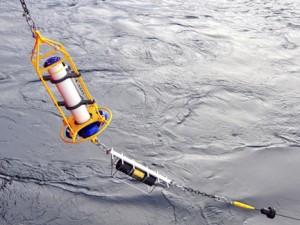
Click to enlarge
The Arctic mooring contains a full suite of biogeochemical sensors, including CO2 and has been used to monitor ocean acidification in the Alaskan Arctic. (Photo: Natalie Monacci, Ocean Acidification Research Center)
Don’t miss the upcoming webinar through the Alaska Center for Climate Assessment and Policy (ACCAP) at the University of Alaska Fairbanks.
- Title: Ocean Acidification: Perceptions, Risks and Uncertainties
- Date: Tuesday, November 5, 10-11am AKDT
- Presenter: Jeremy Mathis, Pacific Marine Environmental Laboratory
& Ocean Acidification Research Center at UAF
Summary
Commercial and subsistence fisheries in Alaska are located in seas projected to experience rapid transitions in pH caused by ocean acidification (OA). Many of the marine organisms that are affected by OA contribute substantially to the state’s commercial activities as well as the gross domestic product (GDP) of the United States. Here, we describe the current patterns of dependence on marine resources within the state that could be negatively impacted by OA and current community characteristics to determine the risk to Alaska’s fishery sector. Our analysis showed that regions in southeast and southwest Alaska that are highly reliant on fishery harvests and have relatively lower income and employment alternatives face the highest risk.
To determine public awareness of this threat we conducted a statewide survey to examine the variables that influence the perceptions of the risk associated with OA. We then used this information to determine if and how individuals react to the current degree of OA in different regions. These results can be used to prepare individuals, communities, and the Alaska fishing industry for future changes in ocean chemistry.
Links:
